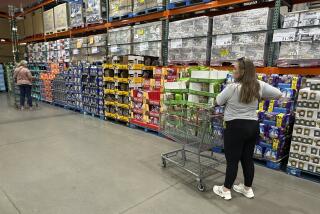Gain in Durable Goods Orders Is Biggest This Year
- Share via
WASHINGTON — Orders poured into U.S. factories at the fastest clip of the year during July just as the red-hot housing sector showed signs of leveling off, according to government and industry reports released Wednesday.
Analysts said the manufacturing revival was occurring at the right time to pick up slack in factory capacity as global demand grows and to let the strained building industry catch up to shortages of labor and materials.
The Commerce Department said orders for costly durable goods shot up a surprising 3.3% to a seasonally adjusted $204 billion--the biggest gain since a 3.8% leap in December--after a slim 0.5% June pickup.
Every sector from car making to computers and defense items benefited from stronger demand in July as manufacturers continued to claw their way back from a slowdown last year when Asian markets were mired in crisis.
Separately, the National Assn. of Realtors said sales of existing homes fell 3.9% in July to a still-strong 5.41 million units a year.
It was the third drop in four months for sales of used homes as mortgage rates crept higher. It came after a huge 12.6% boom in June.
In California, July home sales rose 7% over July 1998, to a seasonally adjusted annualized rate of 710,800 sales. The July rate set another monthly record for the year, a 1.2% increase over June, the previous record.
The median price of an existing single-family detached home in California last month was $222,010, a 5.3% increase over the median for July 1998. The median price for a home in Los Angeles County last month was $205,590, up 0.5% from the same period a year ago.
“What we are beginning to see is some passing of the baton from the housing sector to the manufacturing sector,” said economist Lynn Reaser of Bank of America Private Bank in Jacksonville, Fla.
She said it follows naturally from efforts by Federal Reserve policymakers to nudge interest rates higher as a brake against potential inflationary wage and price rises.
The U.S. central bank raised the federal funds rate for overnight loans among banks a quarter of a percentage point to 5.25% on Tuesday, the second such move in eight weeks, which led several banks to raise their lending rates.
“Housing is where we’d expect to see the greatest impact from interest rate rises, and it’s also where we’ve seen the most signs of overheating from shortages of construction workers and scarcity of supplies like drywall and other building materials,” Reaser said.
The Fed wants to sustain the current expansion, now in its ninth year, by gradually boosting costs for borrowing. Fed Chairman Alan Greenspan has cited a “wealth effect” from rising home prices as one source of consumer spending power.
The broad-based pickup in durable goods orders raised hopes that industry was embarking on a strong second half of the year, bolstered by inventory building ahead of potential year-2000-related computer problems and by stronger overseas sales.
“The report indicates that companies are continuing to purchase equipment that has kept inflation down and productivity up,” said economist Dave Huether of the National Assn. of Manufacturers. “The third quarter is starting out on a very positive note for manufacturers.”
Orders for transportation goods, which account for nearly a quarter of monthly volume, rose 2% to $47.2 billion after a 1.1% advance in June. Car makers already have indicated they intend to crank up their assembly lines for the rest of the quarter to put more vehicles on dealers’ lots.
(BEGIN TEXT OF INFOBOX / INFOGRAPHIC)
Durable Goods
New orders, in billions of dollars, seasonally adjusted:
July: $204 billion
Source: Commerce Department
Existing-Home Sales
Seasonally adjusted annual rate, in millions of units:
July: 5.41 million
Source: National Assn. of Realtors
More to Read
Inside the business of entertainment
The Wide Shot brings you news, analysis and insights on everything from streaming wars to production — and what it all means for the future.
You may occasionally receive promotional content from the Los Angeles Times.







